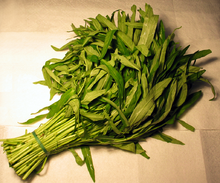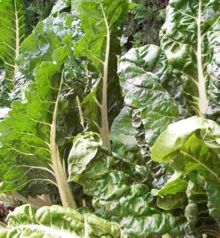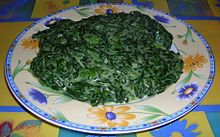- Leaf vegetable
-
 Fresh water spinach
Fresh water spinach Creamed spinach
Creamed spinach
 Steamed kale
Steamed kale
Leaf vegetables, also called potherbs, green vegetables, greens, leafy greens or salad greens, are plant leaves eaten as a vegetable, sometimes accompanied by tender petioles and shoots. Although they come from a very wide variety of plants, most share a great deal with other leaf vegetables in nutrition and cooking methods.
Nearly one thousand species of plants with edible leaves are known. Leaf vegetables most often come from short-lived herbaceous plants such as lettuce and spinach. Woody plants whose leaves can be eaten as leaf vegetables include Adansonia, Aralia, Moringa, Morus, and Toona species.
The leaves of many fodder crops are also edible by humans, but usually only eaten under famine conditions. Examples include alfalfa, clover, and most grasses, including wheat and barley. These plants are often much more prolific than more traditional leaf vegetables, but exploitation of their rich nutrition is difficult, primarily because of their high fiber content. This obstacle can be overcome by further processing such as drying and grinding into powder or pulping and pressing for juice.
During the first half of the 20th century, it was common for greengrocers to carry small bunches of herbs tied with a string to small green and red peppers, known as "potherbs."
Nutrition
Leaf vegetables are typically low in calories, low in fat, high in protein per calorie, high in dietary fiber, high in iron and calcium, and very high in phytochemicals such as vitamin C, carotenoids, lutein, folate as well as vitamin K.
Preparation
Leaf vegetables may be stir-fried, stewed or steamed. Leaf vegetables stewed with pork are a traditional dish in soul food, and southern U.S. cuisine. They are also commonly eaten in a variety of South Asian dishes such as saag. Leafy greens can be used to wrap other ingredients like a tortilla. Most leaf vegetables can also be eaten raw, for example in sandwiches or salads.[citation needed] A green smoothie enables large quantities of raw leafy greens to be consumed by blending the leaves with fruit and water.
See also
- Boiled greens
- Broccoli
- Green smoothie
- List of common leaf vegetables
- List of plants with edible leaves
- Leaf protein concentrate
- Namul
- Spinach (disambiguation)
Categories:- Leaf vegetables
- Vegetable stubs
Wikimedia Foundation. 2010.


